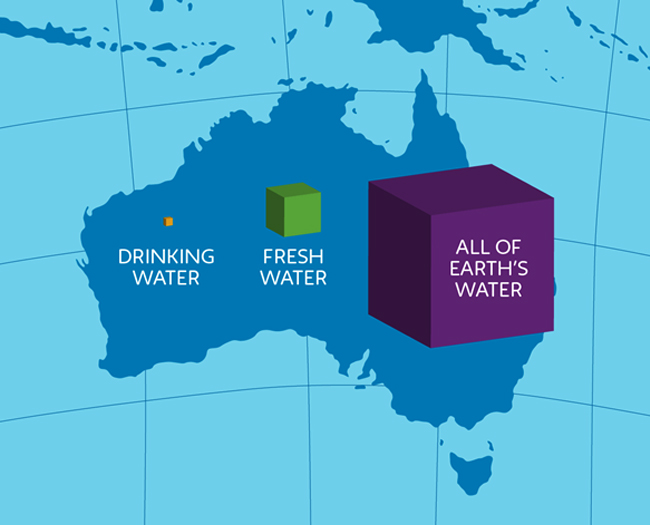Distribution of Earth's water
For anyone who’s been to the ocean or swam at the beach it’s pretty clear that there’s a lot of water on Earth, in fact, in total there’s about 1 385 million cubic kilometres of it. To help wrap your head around this, if all this water, from all our oceans, seas, rivers, lakes, and underground aquifers all over Earth were to be put into a cube, the sides would be about 1115km long. This is about the same distance as Perth to Exmouth.
Of this water about 97% is saltwater found in our oceans, leaving just 35 million cubic kilometres of fresh water. This is the water from all the rivers, lakes, swamps, icecaps and glaciers, and underground water in the world. The sides of this cube would be about 325km in length or the distance from Perth to Augusta.
Most of this water is frozen, or isn’t accessible, leaving a total of 0.1 million cubic kilometres of drinkable water on Earth – this cube would have sides 47 km long, less than the distance from Perth to Mandurah.
This is the water that we share with the entire population of the Earth including all animals. When put into perspective there really isn’t that much available for us to drink. This is why it’s important that we all do our part to conserve this precious resource so we can secure our supply for generations to come.

Sources:
Putting All the World’s Water into a Big Cube, Wait But Why 2013 https://waitbutwhy.com/2013/09/putting-all-worlds-water-into-big-cube.html
Water in Crisis, Oxford University Press 1993 https://www.academia.edu/902661/Water_in_Crisis_Chapter_2_Oxford_University_Press_1993
Freshwater Crisis, National Geographic https://www.nationalgeographic.com/environment/freshwater/freshwater-crisis/
How much water is there on Earth, USGS https://www.usgs.gov/special-topic/water-science-school/science/how-much-water-there-earth
Worldwide Water Supply, USBR 2019 https://www.usbr.gov/mp/arwec/water-facts-ww-water-sup.html